

|
| ČESKÁ REPUBLIKA | CZECH REPUBLIC |
| Plzeňský kraj | Plzeň region |
| Okres: Plzeň-město |
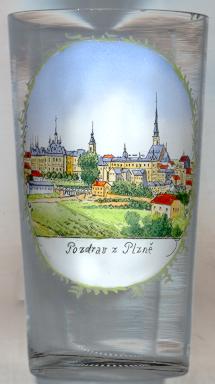
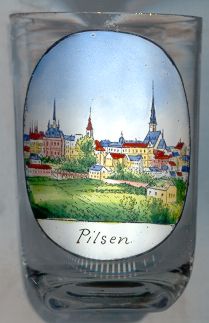 The first written mention of a castle in Plzeň dates from AD 976.
King Václav (Wenzel, Wenceslav) II founded the new town (Nová Plzeň, Neu-Pilsen)
at the confluence of the rivers Mže (Mies) and Radbuza (Radbusa) about 9 km west of the older
settlement of Stará Plzeň (Alt-Pilsen). The town grew rapidly during the following centuries
as it was situated at the crossroads of important trading routes to
Nürnberg, Regensburg and to Saxony.
The first written mention of a castle in Plzeň dates from AD 976.
King Václav (Wenzel, Wenceslav) II founded the new town (Nová Plzeň, Neu-Pilsen)
at the confluence of the rivers Mže (Mies) and Radbuza (Radbusa) about 9 km west of the older
settlement of Stará Plzeň (Alt-Pilsen). The town grew rapidly during the following centuries
as it was situated at the crossroads of important trading routes to
Nürnberg, Regensburg and to Saxony.
Originally, Plzeň had been one of the centres of the Hussite movement. However, after the expulsion of the Hussite leader Jan Žižka the city remained faithful to the catholic denomination during the Thirty Years' War. For that the town received special privileges from Emperor Sigismund relieving her from taxies, duties, tolls and other fees. After the secession of the town from King Jiří (Georg) of Poděbrady (Podiebrad) the inhabitants acknowledged the Matthias Corvinus of Hungary as King of Bohemia. The first printed book in the Czech language, the "Trojan Chronicle" was published in Plzeň in 1468. Plzeň temporarily became the capital of the Empire when Rudolf II set up his residence here between 1599 and 1600 after he fled from Prague which was ravaged by the plague at that time. During the Thirty Years' War (1618–1648) the town was taken in 1618 by the commander of the Protestant troops, count Ernst of Mansfeld, and was not recaptured by the Imperial army until 1621. From December 1633 to February 1634 Albrecht von Wallenstein stayed in the city where he demanded written confirmations of fidelity from his officers (the so-called "Pilsener Revers").
The industrial revolution of the 19th century brought a new period of rapid growth for the city. The Prazdroj brewery, brewing the famous 'Pilsener Urquell', was founded in 1848 and followed the long tradition of brewing bear here (the first written record of a brewery in Plzeň dates from 1307). The engineering Škoda Works were founded in 1859. Extensive railroad lines constructed between 1861 and 1876 brought further development. Today, Plzeň is the capital of the West Bohemia region and has a population of 175,000 inhabitants. Together with Mons (Belgium), Plzeň was selected to be European Capital of Culture for 2015.
The Austrian writer, Gertrud Fussenegger was born in Plzeň in 1912.
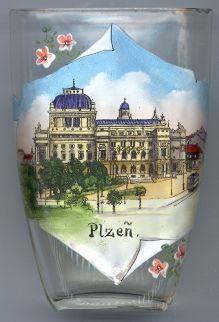
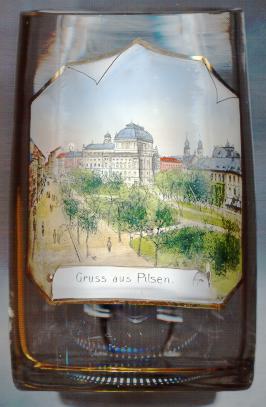
In place of the old town fortifications which had been demolished from 1795 onwards,
several large parks surround the old part of the town. On the south side
 Smetana Park (Smetanovy sady)
[right, no. 622: foreground] was named after the famous composer Bedřich Smetana
(born 1824 in Litomyšl, died 1884 in Prague)
who studied in Plzeň in 1840–1843.
Smetana Park (Smetanovy sady)
[right, no. 622: foreground] was named after the famous composer Bedřich Smetana
(born 1824 in Litomyšl, died 1884 in Prague)
who studied in Plzeň in 1840–1843.
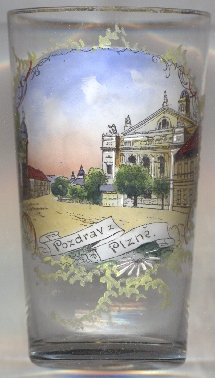
The  Grand Theatre (Velké divadlo
Grand Theatre (Velké divadlo
The  New synagogue
[right, no. 622: background right] was built in 1892 in Romantic Moor-Romanesque style with two symmetric towers
flanking the façade. It is the largest synagogue in Bohemia and the second largest in Central Europe.
New synagogue
[right, no. 622: background right] was built in 1892 in Romantic Moor-Romanesque style with two symmetric towers
flanking the façade. It is the largest synagogue in Bohemia and the second largest in Central Europe.
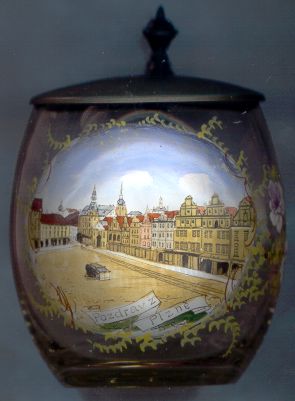
The view depicted on glass no. 2045 [near left] is the northern side of
 Republic
Republic
[https://cs.wikipedia.org/wiki/N%C3%A1m%C4%9Bst%C3%AD_Republiky_(Plze%C5%88)]
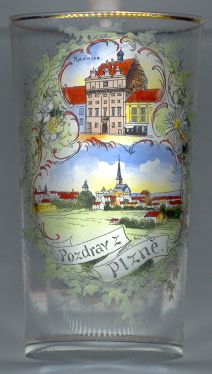
The  town hall (radnice) [left, no. 1761: top picture]
is said to be the most beautiful example of Renaissance architecture in Plzeň. It goes back to the 16th century.
town hall (radnice) [left, no. 1761: top picture]
is said to be the most beautiful example of Renaissance architecture in Plzeň. It goes back to the 16th century.
The Gothic  cathedral of St. Bartholomew [left, no. 1761: bottom picture]
was presumably begun shortly before 1300. The first written mention dates from 1307.
The present church was then built in the 14th century. The oldest part, the presbytery, dates from around 1350, the naves were built in the
late 14th and early 15th century.
Its spire (103 m, 337 ft) is the highest in the Czech Republic.
After a large fire in 1507 the church was restored until 1528.
The Teutonic Order had been patron of the church at formally since 1342. In 1546 the church came under patronage of the city of Plzeň.
Restoration works in the late 19th century aimed at restoring a (neo)-Gothic appearance.
Since 1995 the church is the seat of the bishop of the newly established diocese of Plzeň.
A treasure of the church is the "Pilsner Madonna" of 1384.
cathedral of St. Bartholomew [left, no. 1761: bottom picture]
was presumably begun shortly before 1300. The first written mention dates from 1307.
The present church was then built in the 14th century. The oldest part, the presbytery, dates from around 1350, the naves were built in the
late 14th and early 15th century.
Its spire (103 m, 337 ft) is the highest in the Czech Republic.
After a large fire in 1507 the church was restored until 1528.
The Teutonic Order had been patron of the church at formally since 1342. In 1546 the church came under patronage of the city of Plzeň.
Restoration works in the late 19th century aimed at restoring a (neo)-Gothic appearance.
Since 1995 the church is the seat of the bishop of the newly established diocese of Plzeň.
A treasure of the church is the "Pilsner Madonna" of 1384.
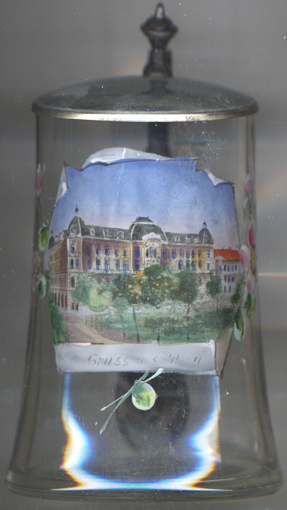
The  Hotel Waldek [near left, no. 4603] was built in 1890–1893 by the architectural company of
Ferdinand Fellner (jr.) and Hermann Helmer (see list of glasses in this collection that show views of buildings created
by these architects) from Vienna in impressive neo-Baroque style. The original name of the hotel was U císera
Ferdinanda ('Emperor Ferdinand'), a name that was already used for the predecessor building from the beginning of the 19th century, which had been
bought by the Augustín Waldek. After breakup of the Austro-Hungarian Monarchy in 1918, the hotel was renamed Hotel Waldek, after the
family of the owners. After the takeover of power in the state by the Communist Party in Czechoslovakia in February 1948, the hotel received the new name
Hotel Slovan, which is still used today.
Hotel Waldek [near left, no. 4603] was built in 1890–1893 by the architectural company of
Ferdinand Fellner (jr.) and Hermann Helmer (see list of glasses in this collection that show views of buildings created
by these architects) from Vienna in impressive neo-Baroque style. The original name of the hotel was U císera
Ferdinanda ('Emperor Ferdinand'), a name that was already used for the predecessor building from the beginning of the 19th century, which had been
bought by the Augustín Waldek. After breakup of the Austro-Hungarian Monarchy in 1918, the hotel was renamed Hotel Waldek, after the
family of the owners. After the takeover of power in the state by the Communist Party in Czechoslovakia in February 1948, the hotel received the new name
Hotel Slovan, which is still used today.
[https://cs.wikipedia.org/wiki/Hotel_Waldek]
![[scale]](lineal.jpg)